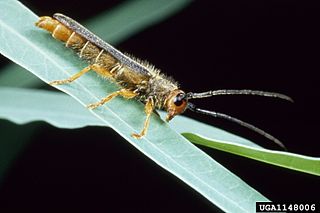
Euphorbia is a very large and diverse genus of flowering plants, commonly called spurge, in the family Euphorbiaceae. "Euphorbia" is sometimes used in ordinary English to collectively refer to all members of Euphorbiaceae, not just to members of the genus.

Euphorbia esula, commonly known as green spurge or leafy spurge, is a species of spurge native to central and southern Europe, and eastward through most of Asia north of the Himalaya to Korea and eastern Siberia. It can also be found in some parts of Alaska.

Aphthona is a genus of beetle, in the leaf beetle family Chrysomelidae, native to Europe and Asia. More specifically, Aphthona are flea beetles, meaning they have enlarged hind legs for jumping away from potential danger. There are some 300 species known worldwide.

Euphorbia myrsinites, the myrtle spurge, blue spurge, or broad-leaved glaucous-spurge, is a succulent species of flowering plant in the spurge family Euphorbiaceae.
Camp Grafton is the main Army National Guard installation in North Dakota. The base, located near Devils Lake, North Dakota, was founded in 1904 as the Rock Island Military Reservation, but later renamed after Gilbert C. Grafton.

Hyles euphorbiae, the spurge hawk-moth, is a European moth of the family Sphingidae. It has been found in Pontresina, Switzerland. This hawk moth is used as an agent of biological pest control against the noxious weed leafy spurge, but usually only in conjunction with other agents. The larvae consume the leaves and bracts of the plant. The species was first described by Carl Linnaeus in his 1758 10th edition of Systema Naturae.
Leafy spurge may refer to several species of plant in the genus Euphorbia, including:
Aphthona abdominalis is a species of leaf beetle known as the minute spurge flea beetle. It was used as an agent of biological pest control against the noxious weed leafy spurge, but never established a viable population.
Aphthona cyparissiae is a species of leaf beetle known as the brown dot leafy spurge flea beetle. It is used as an agent of biological pest control against the noxious weed leafy spurge.
Aphthona czwalinae is a species of leaf beetle known as the black leafy spurge flea beetle. It is used as an agent of biological pest control against the noxious weed leafy spurge.

Euphorbiaceae, the spurge family, is a large family of flowering plants. In English, they are also commonly called euphorbias, which is also the name of the type genus of the family. Most spurges, such as Euphorbia paralias, are herbs, but some, especially in the tropics, are shrubs or trees, such as Hevea brasiliensis. Some, such as Euphorbia canariensis, are succulent and resemble cacti because of convergent evolution. This family has a cosmopolitan global distribution. The greatest diversity of species is in the tropics; however, the Euphorbiaceae also have many species in nontropical areas of all continents except Antarctica.

Chamaesphecia empiformis is a moth of the family Sesiidae.

Chamaesphecia tenthrediniformis is a moth of the family Sesiidae.
Aphthona lacertosa is a root-feeding flea beetle of the genus Aphthona. It is one of 5 Aphthona spp. that has been used in Alberta, Canada to control leafy spurge, an invasive plant that reduces pasture quality and degrades natural habitats.
Aphthona nigriscutis is a root-feeding flea beetle of the genus Aphthona. It is one of five Aphthona spp. that has been used in Alberta, Canada to control leafy spurge, an invasive plant that reduces pasture quality and degrades natural habitats. It, along with A. lacertosa, is one of only two biocontrol agents thought to be effective against leafy spurge.

Chamaesphecia hungarica, the Hungarian clearwing moth, is a moth of the family Sesiidae. It is native to the south-eastern Czech Republic and Slovakia, Austria, Hungary, Serbia and Croatia. It was originally approved for introduction into the United States in 1993. It has been released at several leafy spurge-infested sites in Montana and North Dakota.

Oxicesta geographica is a moth of the family Noctuidae. It is found in southern Romania, Austria, Hungary, from the former Yugoslavia to northern Greece and Turkey. It has also been reported from Russian Moldavia and Georgia.
Sparganothis umbrana is a species of moth of the family Tortricidae first described by William Barnes and August Busck in 1920. It is found in North America, including Alberta, Colorado, Iowa, Maryland, Nevada, New Brunswick, New Jersey, New York, Newfoundland, Ohio, Ontario, Oregon, Quebec, Saskatchewan, South Carolina and Vermont.

Oberea erythrocephala, the leafy spurge stem boring beetle or red-headed leafy spurge stem borer is a species of longhorn beetle that is a biological control agent for leafy spurge. It is an effective killer of the pest but only works on certain strains of leafy spurge, namely the subgenus Esula of the genus Euphorbia. Because of this, the beetle is considered as secondary in leafy spurge control to five species of Aphthona flea beetle.

Euphorbia virgata, commonly known as leafy spurge, wolf's milk leafy spurge, or wolf's milk is a species of spurge native to Europe and Asia, and introduced in North America, where it is an invasive species.













